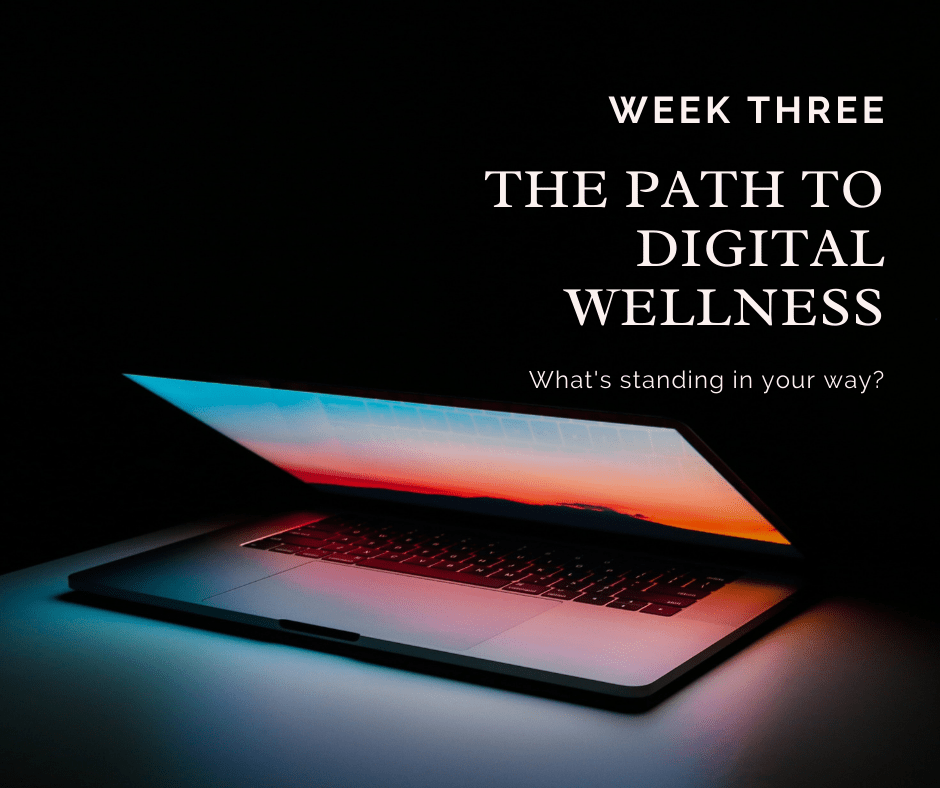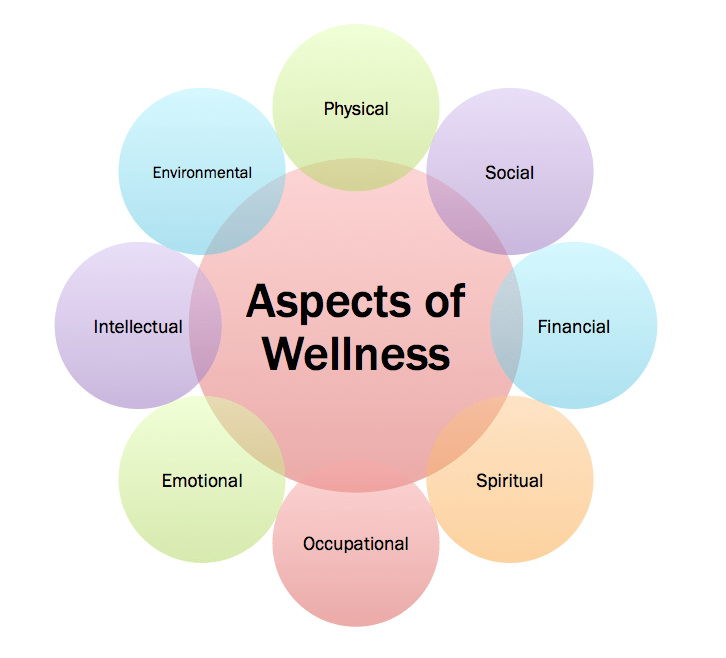When technology holds you back
In week one, we talked about what you want to do with your life, and in week two we talked about what you need to do. Now, let’s focus on the rest of your life— the space between those two states — and how you might be using technology to fill it.
Since the purpose of this course is “wellness,” it might be helpful to start with the question: how does a well/healthy person allocate the time they have in their day and in their life?
Wellness is about having balance between different aspects of your life, which are often broken down into broad categories such as physical, emotional, spiritual, social, occupational, financial, intellectual, and environmental.
(In other words, a “well” person spends time on things that improve how they feel in their mind, their job, their relationships, their home, their body, etc.)
Technology can certainly play a supportive, essential role in a person’s work in all of these categories. For example, you might support your physical wellness by using a Fitbit each day or your financial wellness by using budgeting software.
However, technology, can also play an unhealthy role in each category. For instance, hours spent repetitively scrolling screens might cause pain and/or suck up the time you’d normally be using for exercise and lead to decreased physical wellness, or online shopping habits may strain your financial wellness.
Part of the path to digital wellness will be to get a better sense of where we might be unbalanced and identifying if technology is playing a role in making that happen.
When technology fills the void
Not only can technology hinder our ability to find balance, it can also contribute to us staying stuck in an unbalanced state.
Most of us have at least one area of our lives — body, relationships, career, etc. — that’s not as healthy or developed as the others. Rather than celebrating this as a universal problem we all share, it’s human nature to instead feel guilt and shame about this area of perceived “brokenness.”
Not only do we not actively work on addressing these problem areas, many of us avoid even thinking about them. Technology is perfectly designed to help us with that task.
Sure we can use technology to get answers and solve problems, (The Internet contains all of the information we’ve gathered as a species, surely some of it can lead to insight and inspiration). But when we’re starting from a place of guilt or shame it’s more apt to simply fill a void and keep us distracted.
It’s only when we’re able to look at our unbalanced life honestly and objectively, and (this is important) we’re in the right place emotionally to work on fixing the problems, that we can effectively put technology to work for us and actually make changes in our lives.
This Week’s Exercise
This week, I invite you to explore four questions in your notebook/journal/doc, the answers to which will provide the foundation for the work we’ll be doing the next few weeks to help bring your life into better balance.
- First, looking at the wellness model above, identify if there is an area(s) that is underdeveloped in your life. If so, write that area(s) down and make a note if technology is playing a role in the problem. Note: the area(s) you pick should align with the goal(s) you identified in week one. If not, then you’ve got a disconnect in your plans and are setting goals for stuff that’s already going great in your life, rather than working on the stuff that’s not.
- Second, if you completed last week’s exercise (and no judgement if you did not) look again at that third column of technology you want in your life. Is there anything on this list you already suspect is problematic for you? (Maybe it just came up again in that the step above?) If you don’t know, don’t worry about it. However, if there is, circle, star, highlight it, or write it down. Next week we’re going to start collecting data on your usage of this technology to see if your suspicions are true.
- Third, (if you know and if want to explore this question) write down a list of the things you are consciously avoiding in your life right now — the things from which you are using technology to actively distract yourself. For example, I would prefer to binge watch TV than have tough conversations with people about my feelings. (I bet I’m not alone in that.) Again, no judgement here. All we want to know know is that it’s a thing you’re doing. You don’t have to know why.
- Lastly, if you think you are prone to distract yourself with technology, note if there are particular times of the day/week or situations when it is more apt to happen. Again, no need to jump to conclusions and define why this is happening. We’re just collecting data here.
When you’re done with these four steps you should have a good sense of the problem you need to address — namely, the stuff you need to work on, ways you’ve avoiding doing that work, how/when you’re avoiding it, and a list of tools you’re using to do the avoiding.
Let me remind you for the umpteenth time: DO NOT JUDGE THE INFO THAT COMES UP. Everyone has problem areas. If anything, feel good because you’re taking the proactive step of writing your problem areas down and honoring your authentic wishes and desires to start addressing them.
The next three weeks we’re going to dig deeper into the problem you’ve outlined and get familiar with what exactly is going on so we can come up with an action plan to address it.
Thank you for stopping by. I look forward to seeing you again next week!
Want to participate in this eCourse?
1. Continue to drop by my blog or Medium account each Saturday where you can read the weekly post at your leisure, or…
2. Subscribe to this email list and I’ll send you a post each Saturday.
I’d love to hear your thoughts on this course as we go. Feel free to leave comments on any of the posts or email me at jen@jenkane.com if you’d like to share something privately.






